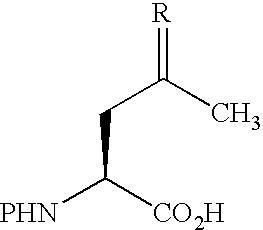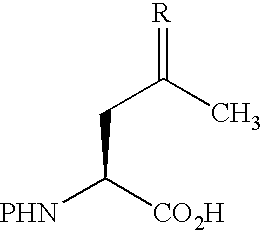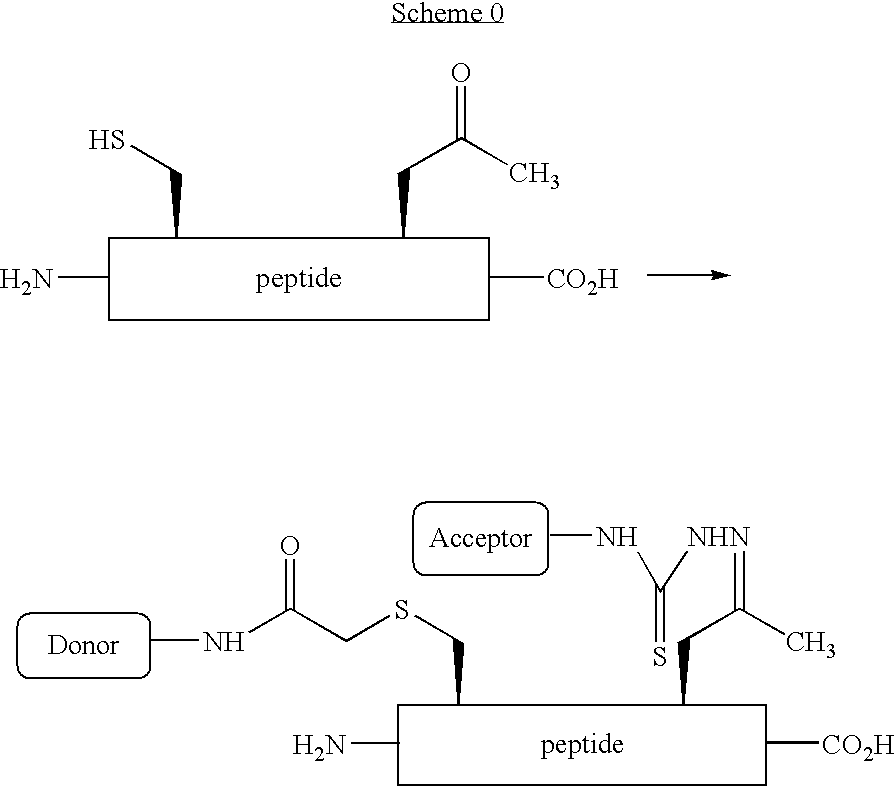Synthetic peptides, conjugation reagents and methods
a technology of synthetic peptides and conjugation reagents, applied in the field of synthetic peptides, conjugation reagents and methods, can solve the problems of preventing clinical evaluation and approval, special challenges of glycosylation,
- Summary
- Abstract
- Description
- Claims
- Application Information
AI Technical Summary
Benefits of technology
Problems solved by technology
Method used
Image
Examples
example i
[0011] Direct incorporation of unprotected ketone groups into peptides during solid phase synthesis: application of the one-step modification of peptides with two different biophysical probes for FRET.
[0012] Abstract: An amino acid bearing an unprotected ketone group, (2S)-aminolevulinic acid, was incorporated into a synthetic peptide using standard Fmoc-based solid-phase methods. The ketone group remained unharmed during the synthesis and provided a uniquely reactive functional group for covalent modification of the peptide. The ketone and the sulfhydryl group of a cysteine residue elsewhere in the peptide were reacted simultaneously with two different biophysical probes, enabling the site-specific installation of a donor and acceptor pair for FRET in one step without the need for differential side chain protection.
The fluoresence resonance energy transfer (FRET) technique has found widespread use in the study of protein structure and dynamics.1 The technique requires the insta...
example ii
Synthesis of an oxime-linked neoglycopeptide with glycosylation-dependent activity similar to its native counterpart.
[0034] Abstract: Neoglycopeptides containing an oxime sugar-peptide linkage can be generated by coupling an aminooxy sugar with a peptide bearing a keto-amino acid. The coupling reaction can be executed in aqueous milieu without need for protecting groups on the peptide or saccharide, or auxiliary coupling reagents. Using this method, an oxime-linked analog of an antimicrobial peptide with glycosylation-dependent function was prepared and found to have similar bioactivity to the native glycopeptide. Thus, replacement of the sugar-peptide bond with an unnatural but synthetically facile linkage can produce functional neoglycopeptides.
[0035] An appealing strategy for the assembly of glycopeptides is the convergent coupling of an oligosaccharide with a pre-formed peptide. While this strategy has been implemented in the synthesis of N-linked glycopeptides,1 O-linked gly...
example iii
Aminooxy, hydrazide and theosemicarbazide-functionalized saccharides: versatile reagents for glycoconjugate synthesis.
[0057] ABSTRACT: Saccharides functionalized at their reducing termini with aminooxy, hydrazide or thiosemicarbazide groups are versatile reagents for the synthesis of glycoconjugates using chemoselective ligation reactions. They can be prepared from aminoglycosides without the requirement for protecting groups on the saccharide. Novel neoglycopeptides were constructed by the condensation of aminooxy and thiosemicarbazide-functionalized oligosaccharides with ketone groups on an unprotected peptide scaffold. In this fashion, we synthesized neoglycopeptides bearing the chitobiosyl moiety found in N-linked glycopeptides, or a sialyl Lewis x motif found in O-linked glycopeptides.
[0058] Organic chemists have exercised significant creativity in the construction of glycoconjugate assemblies as tools for studying carbohydrate recognition and as potential therapeutic agents....
PUM
| Property | Measurement | Unit |
|---|---|---|
| volume | aaaaa | aaaaa |
| volume | aaaaa | aaaaa |
| particle size | aaaaa | aaaaa |
Abstract
Description
Claims
Application Information
 Login to View More
Login to View More - R&D
- Intellectual Property
- Life Sciences
- Materials
- Tech Scout
- Unparalleled Data Quality
- Higher Quality Content
- 60% Fewer Hallucinations
Browse by: Latest US Patents, China's latest patents, Technical Efficacy Thesaurus, Application Domain, Technology Topic, Popular Technical Reports.
© 2025 PatSnap. All rights reserved.Legal|Privacy policy|Modern Slavery Act Transparency Statement|Sitemap|About US| Contact US: help@patsnap.com



